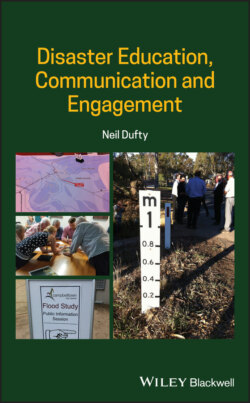Читать книгу Disaster Education, Communication and Engagement - Neil Dufty - Страница 13
2.2.1.2 Risk Perception
ОглавлениеThe extensive body of research on risk perception helps to clarify people's innate biases and provide insights into how cultural, social, and emotional factors shape actual perception of risk. These learnings can then be translated to make risk communication more effective.
Knowledge, experience, values, attitudes, and feelings all influence the thinking and judgement of people about the seriousness and acceptability of risks.
The mental models and other psychological mechanisms which people use to judge risks are internalised through social and cultural learning and constantly moderated (reinforced, modified, amplified, or attenuated) by media reports, peer influences, and other communication processes (Morgan et al. 2001).
According to Renn (2008), there are two main approaches to the study of risk perception:
1 The ‘realist approach’. This approach aims to bring perception as close as possible to the actual risk of an activity or an event. It assumes that there is an outside objective world with risks that we can recognise and acknowledge (Rosa 2008). The solutions to problems of perception are then simply ones of more information and a greater understanding of the risk (Wachinger and Renn 2010).
2 The ‘constructivist approach’. Constructivists argue that risks are not objective but that they are subjective and socially constructed (Jasanoff 1998). That is, they are models which allow people to cope with non-reoccurring phenomena (Wachinger and Renn 2010).
Why might the public view hazard risk differently to experts such as emergency managers? People are often presented with a large amount of information (e.g. on potential hazards) and require some way of weighing up that information if they want to reach a conclusion about relevant risks. In general, the public relies on what are called ‘heuristics’ or – more commonly – rules of thumb. Heuristics are quick, informal methods that the brain uses to generate an approximate answer to a problem and allows people to quickly make sense of a complex environment (Renn 2008).
However, using heuristics can also result in biases, where risk perceptions are out of kilter with risk assessments by emergency agencies or other authorities. For example, if someone has experienced a hazard event, they are likely to see one as more probable in the future. Consequently, personal experience can be very important in perception of the level of risk, and reminders of particular risks in the media can also have an effect (Eiser et al. 2012). This ‘availability bias’ through personal experience or ‘local knowledge’ can improve local risk assessment by authorities through a cooperative approach (Dufty 2016).
‘Optimism bias’ is a cognitive bias that causes people to believe that they are at a lesser risk of experiencing a hazard event compared to others. This can cause them to opt out of any thinking (and resultant action) towards a particular disaster risk, believing ‘this is not going to happen to me’. On the other hand, individuals may tend to overestimate the potential for exposure and the extent of a hazard, thinking that they are more dangerous in comparison to other risks (Science Communication Unit 2014).
Of importance to risk communication is the fact that research shows cultural background influences risk perception. Compared with individuals in Western Europe, for example, people from many Eastern European countries are more likely to see economic or social risks as greater than technological risks (Science Communication Unit 2014).
Renn (2008) has designed a model of risk perception which shows the dynamics between the complex layers of factors, including cultural background, heuristics, and biases. Also of note are people's beliefs and values, their socio-economic status, and world views.
The relationships between risk perception and emergency behaviours (e.g. preparedness, evacuation, and recovery) are discussed in Section 5.2.
